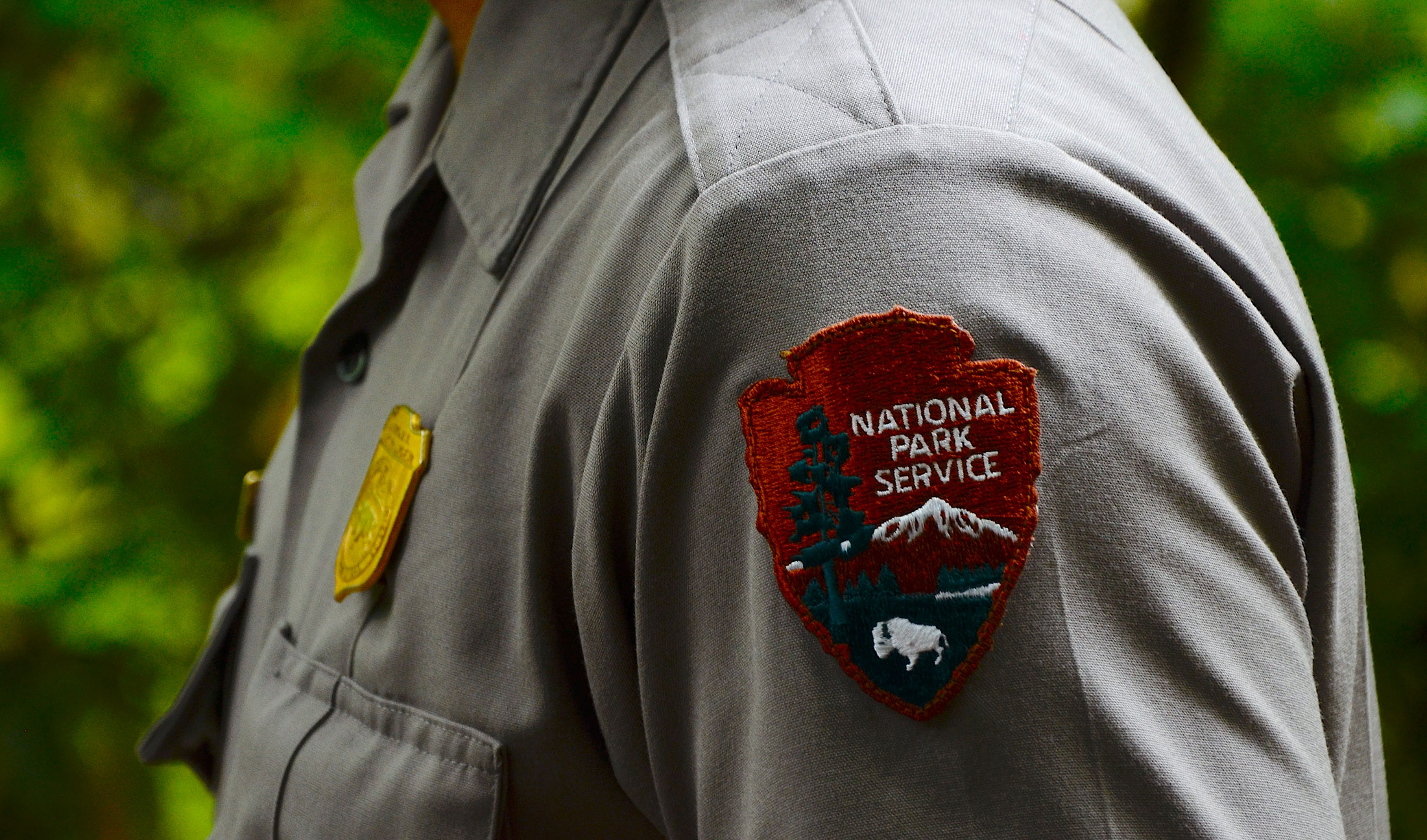
To experience Deep Creek Trail in Great Smoky Mountains National Park is to experience the presence of water. It flows through placid runs, over rocky riffles, and down the stony faces of Indian Creek and Toms Branch waterfalls. It feeds the trees, the wildflowers, the mosses, and the lichens. The sound of its journey is a constant backdrop to the rustling of wind in the trees and the intermittent announcements of birds and squirrels sounding through the forest.
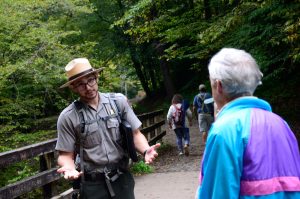
But there’s a fascinating world of science and history behind this beautiful backdrop—and during a hiking program earlier this fall, Seasonal Interpretive Ranger Cody Boettner lifted the curtain on the intersection of human culture and natural phenomena that make this place what it is. The hike was one of more than 20 different ranger programs offered this fall—many of which repeated multiple times each week—open to anyone who cared to join, no fee or registration required.
Boettner said Deep Creek’s multiple waterfalls make it one of his favorite places in the Smokies. He has had a special appreciation for cascading water since completing a previous National Park Service season at Yosemite National Park in California, home of Yosemite Falls, the tallest waterfall in North America.
“I got the chance to see that waterfall every day, and I started to contemplate, what is it about water that brings people together?” he said at the beginning of the program. “What is it about waterfalls that draw us to waterfalls?”
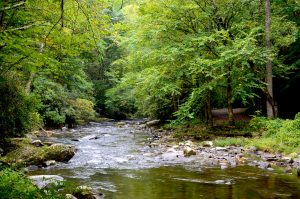
Over the course of one hour, three quarters of a mile, and two waterfalls, Boettner brought together chemistry, culture, and natural history as he attempted to answer those questions. A ten-minute stroll brought us to our first stop, Toms Branch Falls, where a gentle cascade of water falls over 80 feet of rocky shelves. It’s a sight that inspires feelings of peace and harmony—feelings that are perhaps boosted by the large number of negative ions found near waterfalls. Scientific research has linked exposure to these ions with various mental health benefits, offering a possible scientific explanation for the tranquility that people have long found in these natural settings.
Walking a little farther, we came to a bridge that crosses a wide, placid stretch of Deep Creek, where we watched fish swimming in the clear water below. Boettner used the sighting as a springboard to talk about the diversity of species that live in Smokies streams, and the deleterious effect unsustainable pre-park logging practices had on their abundance. The hike ended at 45-foot Indian Creek Falls, where Boettner discussed the Cherokee spiritual practice of “going to water,” and the importance these waterways still hold in Cherokee culture today.
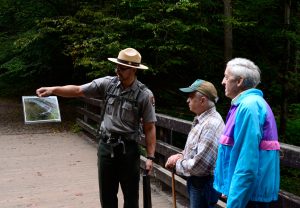
Program participants said the hike offered “a new perspective and a deeper understanding” of the park and the natural environment it contains, and an “informative” and “interesting” way to experience the outdoors. Due to a poor weather forecast, on this particular day brothers Keith and Chuck Waugaman—of Hendersonville, North Carolina, and Lexington, Kentucky, respectively—were the only other people on the hike. But Boettner said that over the summer, he’d lead as many as 15 people at a time, and during leaf season last year he once counted 30.
Ranger programs like this one are an integral part of the National Park Service experience, but they all but disappeared following the onslaught of the COVID-19 pandemic in 2020. The park was one of the many anchor institutions to shut down completely, closing to the public from March through June 2020. When it reopened, ranger programs were gone in favor of one-on-one visitor interactions deemed safer amid the unfolding public health crisis—rangers were sparking conversations on trails, at overlooks, or over pop-up displays.
The park began to dip its toe into resuming traditional ranger programs in 2022 as it simultaneously grappled with pressure from the heightened visitation that followed the pandemic. Since then, it’s worked to gradually ramp up these offerings, finally reaching pre-pandemic programming levels this year.
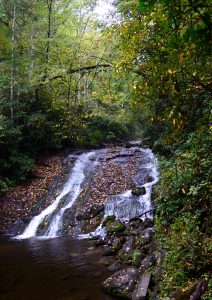
Support from Smokies Life helped make that expansion possible. Since January 2023, Smokies Life employees have begun staffing information desks in the Sugarlands and Oconaluftee visitor centers, answering basic visitor questions alongside many long-serving NPS volunteers. This freed up the resource education rangers who had been filling those roles to spend more time interacting with visitors throughout the park. Though most ranger programs are now on hiatus as winter sets in, park visitors can look forward to a new menu of options when spring returns.
“Seeing rangers out in the field, it brings about a learning opportunity for visitors to better connect with the place,” Boettner said. “It brings about security of the place, and it also maybe even humanizes us a little bit—we’re not somebody that is behind the desk, regulating from a computer. We are there with you in these wild and scenic places.”
Boettner’s role on the trail extended beyond the interpretive program he’d come prepared to deliver. During the stop at Toms Branch Falls, he offered a hand to an angler who was having a hard time getting back up the bank, and she gratefully accepted. He checked in with any visitors we passed who looked like they might need help or direction, and he provided some impromptu environmental education to a pair of hikers we passed on the return trip, when a Blue Ridge two-lined salamander scurried out into the path. These interactions are as much a goal of ranger programs as the content itself, said Chief of Resource Education Stephanie Kyriazis.
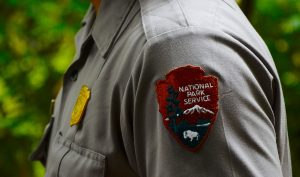
“We’re not only able to provide help to visitors, whether it’s physical help or customized information, but also we know that when there is a ranger present in a space, people are less likely to engage in negative stewardship behavior,” she said. “They’re less likely to litter, less likely to drive off-road or have their dogs where they’re not supposed to—those sorts of things. So we feel like having ranger presence out there also means we’re encouraging others to do a better job of taking care of their national park.”
Stewardship fosters connection, and connection—whether through guided hikes, ranger-led talks, or individual conversations—is what a ranger’s job is all about.
“These are things that help people get connected to these resources,” Boettner said, “which ultimately helps to create stewardship for this area from the public.”
For a current list of ranger programs, pick up the Smokies Guide newspaper at any park visitor center, or check the calendar at nps.gov/grsm/planyourvisit/calendar.htm. Winter is typically a slower season for ranger programs, with more offerings returning during the spring, summer, and fall.
Subscribe to get the latest posts sent to your email.
The Great Smokies Welcome Center is located on U.S. 321 in Townsend, TN, 2 miles from the west entrance to Great Smoky Mountains National Park. Visitors can get information about things to see and do in and around the national park and shop from a wide selection of books, gifts, and other Smokies merchandise. Daily, weekly, and annual parking tags for the national park are also available.